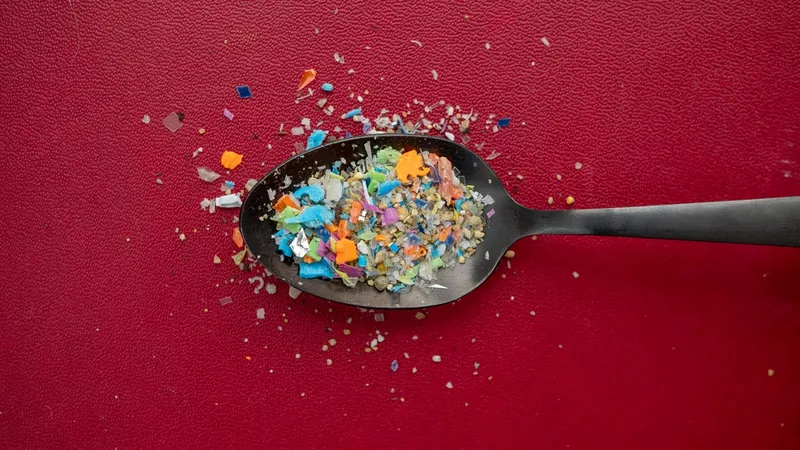
Stop Eating Plastic: 7 Kitchen Items Secretly Full of Microplastics!
2025-09-07
Author: Wei
Microplastics: The Invisible Threat in Your Kitchen
Microplastics have infiltrated nearly every aspect of our lives—flowing in our water, circulating in the air, and even sneaking into the food we eat. These minuscule plastic particles are not merely an environmental issue; they are a ticking health bomb that’s starting to garner serious attention.
Recent studies highlight alarming findings: microplastics can accumulate in human tissues, particularly in vital organs, potentially leading to severe health concerns such as dementia. Understanding the sources of these contaminants in our homes, especially the kitchen, is vital to minimizing our exposure.
Are Microplastics Hazardous to Your Health?
Over the years, scientists have raised concerns about the implications of ingesting microplastics. On average, humans inhale or consume about 22 million micro- and nanoplastics annually, primarily through everyday activities. These particles can enter our systems in three main ways: inhalation, ingestion, and skin contact.
The consequences of microplastics are dire. Issues such as tissue inflammation, reduced fertility, and increased risks of heart attacks and strokes have been linked to microplastics in the bloodstream. Animal studies reveal horrifying outcomes, including genetic mutations and cancer. As research progresses, the urgency for home cooks to rethink their kitchenware intensifies.
Top Kitchen Items Hiding Microplastics
Curious about where these tiny plastics are lurking in your kitchen? Here are seven common items you might want to reconsider!
1. Nonstick Cookware
Your favorite nonstick pans might be leaking millions of microplastics into your meals. Research shows that when heated, these pans release harmful particles that can compromise your health.
2. Plastic Food Containers
The convenience of takeout comes with hidden dangers. Many plastic food containers can leach microplastics into your food, especially when heated. Opt for safer storage solutions!
3. Plastic Utensils
Those handy plastic utensils may be contributing to microplastic exposure, particularly with hot foods. You might be consuming more than just your meal!
4. Tea Bags
Brew your tea with caution! Many tea bags are made from polypropylene, releasing billions of microplastics when exposed to hot water.
5. Certain Spices
Your spices may not be as harmless as they seem. Recent findings reveal plastic packaging could lead to microplastic contamination in your favorite seasonings.
6. Plastic Straws
Plastic straws aren’t just environmentally harmful; they can also release harmful particles into your food and drink. Time to make the switch!
7. Canned Food Linings
Beware of the linings in your canned foods! Many modern versions still contain microplastics, making fresh or frozen options a better choice.
How to Reduce Microplastic Exposure in Your Kitchen
The good news is you can take simple steps to ward off these hidden dangers! Here are some kitchen swaps to consider:
Use Wooden or Stainless-Steel Utensils
Ditch the plastic! Wooden or stainless-steel utensils not only reduce microplastic exposure but add a touch of style to your kitchen.
Switch to Glass or Stainless Steel Containers
Choose glass, ceramic, or stainless steel for food storage. These materials keep harmful plastics at bay.
Brew Loose Leaf Tea
Go for loose tea leaves instead of plastic tea bags, using a stainless steel strainer for a much safer tea experience.
Opt for Bulk or Glass Packaging for Spices
Purchase spices in bulk or in glass containers to avoid unnecessary plastic contamination.
Try Reusable Straws
Transition to reusable metal or bamboo straws. Not only are they better for your health, but they also reduce plastic waste!
Choose Fresh or Frozen Produce
Skip canned food or seek out glass-packaged options. Fresh and frozen produce can greatly reduce your microplastic intake.
Upgrade Your Cookware
Invest in high-quality cookware made from stainless steel, cast iron, or carbon steel to eliminate plastic exposure in your cooking.
The Overarching Verdict
The presence of microplastics in our kitchens is alarming and demands immediate attention. By swapping out common kitchen items for safer alternatives, we can take proactive steps toward protecting our health and the environment. Stay informed and make conscious choices to keep your meals microplastic-free!





 Brasil (PT)
Brasil (PT)
 Canada (EN)
Canada (EN)
 Chile (ES)
Chile (ES)
 Česko (CS)
Česko (CS)
 대한민국 (KO)
대한민국 (KO)
 España (ES)
España (ES)
 France (FR)
France (FR)
 Hong Kong (EN)
Hong Kong (EN)
 Italia (IT)
Italia (IT)
 日本 (JA)
日本 (JA)
 Magyarország (HU)
Magyarország (HU)
 Norge (NO)
Norge (NO)
 Polska (PL)
Polska (PL)
 Schweiz (DE)
Schweiz (DE)
 Singapore (EN)
Singapore (EN)
 Sverige (SV)
Sverige (SV)
 Suomi (FI)
Suomi (FI)
 Türkiye (TR)
Türkiye (TR)
 الإمارات العربية المتحدة (AR)
الإمارات العربية المتحدة (AR)